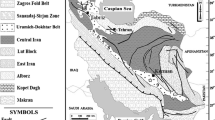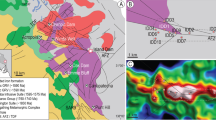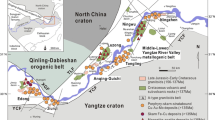Abstract
Thin- to medium-bedded, stratiform calc-silicate deposits (banded skarns) are a peculiar, but important, component of the supracrustal successions in the Palaeoproterozoic Bergslagen mining district of central Sweden. They are referred to as “skarn-banded leptites” in the literature and are common in areas and at stratigraphic levels that contain iron oxide and base metal sulphide deposits. The stratigraphic hanging wall of the stratabound Ryllshyttan Zn–Pb–Ag + magnetite deposit at Garpenberg, contains approximately 100–150 m of interbedded aluminous skarn beds and rhyolitic ash-siltstones. The skarn beds are mineralogically variable and dominantly composed of grandite, spessartine, epidote, actinolite, quartz, clinopyroxene, and locally magnetite. Integrated field-mapping, and whole-rock lithogeochemical, microscopic and mineral chemical analyses suggest that the stratiform skarn beds are the products of at least two discrete hydrothermal events and subsequent metamorphism. The first event comprised accumulation in a quiescent subaqueous environment, below wave base, of calcareous and ferruginous sediments rich in Fe, Mn, Ca, and Mg. These chemical sediments were deposited concurrently with rhyolitic ash-silt sedimentation, thus forming a (now metamorphosed) laminated calcareous Fe formation with both a detrital rhyolitic component and rhyolitic siltstone interbeds. Positive Eu-anomalies and negative Ce-anomalies for normalized rare earth element analyses of skarn beds suggest that the iron may have been derived from exhalation of hot and reduced hydrothermal fluids, which upon mixing with more oxidized seawater, precipitated Fe oxides and/or carbonates that settled from suspension to the seafloor. The size of the positive Eu-anomalies of the chemical sediments are modified by the content of rhyolitic volcaniclastic material, which has a negative Eu anomaly, such that positive Eu-anomalies are only observed in skarn beds that possess a minor volcaniclastic component. Subsequently, the calcareous Fe formations were subjected to post-depositional alteration by hydrothermal fluids, locally yielding more manganoan and magnesian assemblages. The Mn-alteration is manifested by lateral gradations from epidote-grandite-clinopyroxene±magnetite rocks into significantly more Mn-rich quartz-spessartine rocks and massive andradite rocks over distances of less than 10 cm within individual skarn beds. Magnesian alteration is manifested by the development of discordant zones of pargasite para-amphibolites and formation of stratiform pargasite rocks texturally similar to the interlaminated grandite-epidote-ferroan diopside rocks. The latter increase in abundance towards the Ryllshyttan deposit and are associated with pre-metamorphic/pre-tectonic K–Mg–Fe±Si alteration (now biotite-phlogopite-garnet-cordierite-pargasite rocks) that is related to base metal mineralization. The zone of Mn- and Mg-altered skarn beds extends beyond the zone of pervasive K–Mg–Fe±Si alteration around Ryllshyttan. This suggests that the skarn bed progenitors, or their sedimentary contacts against rhyolitic ash-siltstones, acted as conduits to outflowing hydrothermal fluids. The chemical and mineralogical imprint, imposed on affected beds by alteration, may serve as indicators of proximity to intense K–Mg–Fe±Si alteration envelopes around other base metal sulphide deposits in Bergslagen. The last recorded event comprised syn-tectonic veining of competent massive andradite skarn beds. The veins contain quartz-albite-epidote-ferroan diopside-actinolite assemblages.























Similar content being viewed by others
References
Allen RL, Lundström I, Ripa M, Simeonov A, Christofferson H (1996) Facies analysis of a 1.9 Ga, continental margin, back-arc, felsic caldera province with diverse Zn–Pb–Ag–(Cu–Au) sulfide and Fe oxide deposits, Bergslagen Region, Sweden. Econ Geol 91:979–1008
Allen RL, Bull S, Ripa M, Jonsson R (2003) Regional stratigraphy, basin evolution, and the setting of stratabound Zn–Pb–Cu–Ag–Au deposits in Bergslagen, Sweden. Geol Surv Sweden, Final report for Boliden Mineral and SGU-FoU Project 03-1203/99, pp 78.
Barrett TJ, MacLean, WH (1994) Chemostratigraphy and hydrothermal alteration in exploration for VHMS deposits in greenstones and younger volcanic rocks. In: Lentz DR (ed) Alteration and alteration processes associated with ore-forming systems: Geol Assoc Can Short Course Notes 11:433–467.
Boström K (1973) The origin and fate of ferromanganoan active ridge sediments. Stockholm Contrib Geol 27:147–243
Boström K, Peterson MNA (1969) The origin of aluminum-poor ferromanganoan sediments in areas of high heat flow on the East Pacific Rise. Mar Geol 7:427–447
Boyd TD, Scott SD (2001) Microbial and hydrothermal aspects of ferric oxyhydroxides and ferrosic hydroxides; the example of Franklin Seamount, westen Woodlark Basin, Papua New Guinea. Geochem Trans 2:45–56
Chavagnac V, German CR, Milton AJ, Palmer MR (2005) Sources of REE in sediment cores from the Rainbow vent site (36° 14′ N, MAR). Chem Geol 216:329–352
Deer WA, Howie RA, Zussman J (1992) An introduction to the rock-forming minerals, 2nd edn. Pearson Prentice Hall, Essex, p 696
Gaspar M, Knaack C, Meinert LD, Moretti R (2008) REE in skarn systems: a LA-ICP-MS study of garnets from the Crown Jewel gold deposit. Geochim Cosmochim Acta 72:185–205
Geijer P, Magnusson NH (1944) De mellansvenska järnmalmernas geologi. Geol Surv Sweden Ca35:654
German CR, Higg NC, Thomson J, Mills R, Elderfield H, Blusztain et al (1993) A geochemical study of metalliferous sediment from the TAG hydrothermal mound, 26° 08′ N, Mid-Atlantic Ridge. J Geophys Res 98(B6):9683–9692
Grant JA (1986) The Isocon diagram—a simple solution to Gresens’ equation for metasomatic alteration. Econ Geol 81:1976–1982
Gross GA (1980) A classification of iron formations based on depositional environments. Can Mineral 18:215–222
Heimann A, Spry PG, Teale GS, Conor CHH, Leyh WR (2009) Geochemistry of garnet-rich rocks in the Southern Curnamona Province, Australia, and their genetic relationship to Broken Hill-type Pb–Zn–Ag mineralization. Econ Geol 104:687–712
Heimann A, Spry PG, Teale GS, Conor CHH, Pearson NJ (2011) The composition of garnet in garnet-rich rocks in the southern Proterozoic Curnamona Province, Australia: an indicator of the premetamorphic physiochemical conditions of formation. Mineral Petrol 101:49–74
Hein JR, Koschinsky A, McIntyre BR (2005) Mercury- and silver-rich ferromanganese-oxides, southern California borderland: deposit model and environmental implications. Econ Geol 100:1151–1168
James HL (1954) Sedimentary facies of iron formation. Econ Geol 49:235–293
Jansson N (2009) The origin of the Ryllshyttan stratabound Zn–Pb–Ag–(Cu)+magnetite deposit, Garpenberg, Bergslagen, Sweden. Licentiate thesis, Luleå University of Technology, ISSN: 1402–1757. pp 37.
Jansson NF, Allen RL (2011) Timing of volcanism, hydrothermal alteration and ore formation at Garpenberg, Bergslagen, Sweden. GFF 133:3–18
Klein C, Beukes NJ (1992) Models for iron-formation deposition. In: Schopf W, Klein C (eds) The Proterozoic biosphere: a multidisciplinary study. Cambridge University Press, Cambridge, p 1348
Kokelaar BP (1986) Magma-water interactions in subaqueous and emergent volcanism. Bull Volcanol 48:275–289
Leake BE, Grice JD et al (2003) Nomenclature of amphiboles: additions and revisions to the International Mineralogical Association’s 1997 Recommendations. Can Mineral 41:1355–1362
Lindroth GT (1920) Om vulkaniska tuffbreccior uti leptitformationen inom Garpenbergsområdet. Geol Fören Förhandl, Bd 42 H 2:57–83
Lindroth GT (1924) Kalk-skarnjärnmalmsfyndigheter som brottstycken uti Bergslagens gnejsgraniter (‘äldre urgraniter’). Geol Fören Förhandl, Bd 46 H 6–7:559–653
Lindroth GT (1926) Bidrag till frågan om kalk-skarnjärnmalmernas genesis. Geol Fören Förhandl, Bd 48 H 3:357–409
McPhie J, Doyle M, Allen R (1993) Volcanic textures—a guide to the interpretation of textures in volcanic rocks. University of Tasmania, Centre for Ore Deposit and Exploration Studies, p 198
Meinert LD, Dipple GM, Nicolescu S (2005) World skarn deposits. Economic Geology 100th Anniversary Volume: 299–336.
Oen IS, Helmers H, Verschure RH, Wiklander U (1982) Ore deposition in a Proterozoic incipient rift zone environment: a tentative model for the Filipstad-Grythyttan-Hjulsjö region, Bergslagen, Sweden. Geol Rund 71:182–194
Peter JM (2003) Ancient iron formations: their genesis and use in the exploration for stratiform base metal sulphide deposits, with examples from the Bathurst Mining Camp. In Lentz, D.R. (ed) Geochemistry of sedimentary rocks: evolutionary considerations to mineral deposit-forming environments. Geol Assoc Can GeoText 4:145–176
Peter JM, Goodfellow WD (1996) Mineralogy, bulk and rare earth element geochemistry of massive sulphide-associated hydrothermal sediments of the Brunswick horizon, Bathurst mining camp, New Brunswick. Can J Earth Sci 33:252–283
Plimer IR (2006) Manganoan garnet rocks associated with Broken Hill Pb–Zn–Ag orebody, Australia. Mineral Petrol 88:443–478
Slack JF, Grenne T, Bekker A, Rouxel OJ, Lindberg PA (2007) Suboxic deep seawater in the late Paleoproterozoic: evidence from hematitic chert and iron formations related to seafloor-hydrothermal sulfide deposits, central Arizona, USA. Earth Planet Sci Lett 255:243–256
Spry PG, Peter JM, Slack JF (2000) Meta-exhalites as exploration guides to ore. Rev Econ Geol 11:163–201
Spry PG, Heimann A, Messerly JD, Houk RS (2007) Discrimination of metamorphic and metasomatic processes at the Broken hill Pb–Zn–Ag deposit, Australia: rare earth element signatures of garnet-rich rocks. Econ Geol 102:471–494
Spry PG, Plimer IR, Teale GS (2008) Did the giant Broken Hill (Australia) Zn–Pb–Ag deposit melt? Ore Geol Rev 34:223–241
Stephens MB, Ripa M, Lundström I, Persson L, Bergman T, Ahl M, Wahlgren CH, Persson PH, Wickström L (2009) Synthesis of the bedrock geology in the Bergslagen region, Fennoscandian Shield, south-central Sweden. Geol Surv Sweden Ba58:259
Sundius N (1923) Grythyttefältets geologi. Geol Surv Sweden C312:354
Sverjensky DA (1984) Europium redox equilibria in aqueous solution. Earth Planet Sci Lett 67:70–78
Taylor SR, Maclennan SM (1985) The continental crust: its composition and evolution—an examination of the geochemical records preserved in sedimentary rocks. Blackwell, Oxford, p 312
Törnebohm AE (1875) Geognostisk beskrifning öfver Persbergets Grufvefält. Geol Surv Sweden C14:21
Vivallo W (1984) The metamorphism of the supracrustal rocks at Garpenberg, south central Sweden. Geolog Fören Förhandl 106:257–267
Whitney DL, Evans WB (2010) Abbreviations for names of rock-forming minerals. Am Mineral 95:185–187
Acknowledgements
Boliden Mineral and the Geological Survey of Sweden are greatly acknowledged for funding this research, which is part of research contract 60-1451/2006. Sincere gratitude goes to the staff of Boliden Mineral at Garpenberg for invaluable help with logistics and accommodation during fieldwork. Constructive reviews by Tony Roache (CSIRO) and Krister Sundblad (University of Turku) as well as editorial handling and suggestions by Paul Spry considerably improved this article. Jan Peter (Geological Survey of Canada) is thanked for comments on an earlier draft of the manuscript. Special thanks go to Hans Harryson for performing the EMP analyses and to Milan Vnuk for help with the digitization of field maps.
Author information
Authors and Affiliations
Corresponding author
Additional information
Editorial handling: P. Spry
Rights and permissions
About this article
Cite this article
Jansson, N.F., Allen, R.L. The origin of skarn beds, Ryllshyttan Zn–Pb–Ag + magnetite deposit, Bergslagen, Sweden. Miner Petrol 103, 49–78 (2011). https://doi.org/10.1007/s00710-011-0154-x
Received:
Accepted:
Published:
Issue Date:
DOI: https://doi.org/10.1007/s00710-011-0154-x




